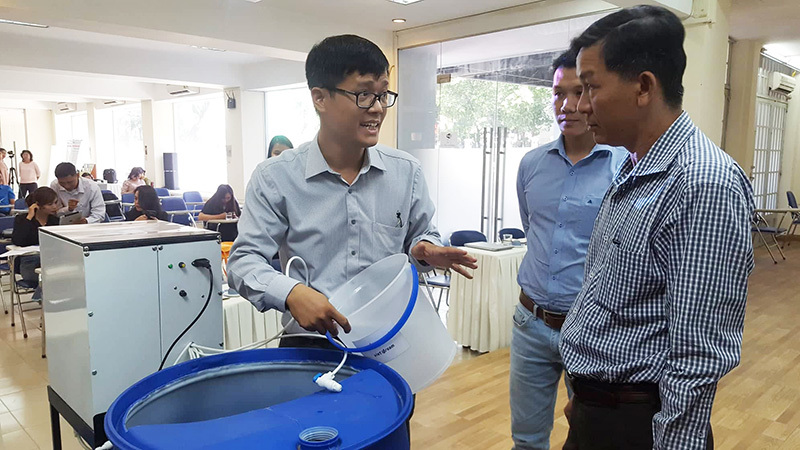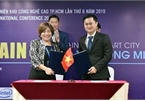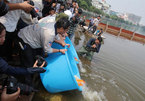After five years of researching CDI technology in the US, Do Huu Quyet from SHTPLabs and co-workers spent two more years of research in Vietnam before making a water purifier with CDI technology, called Vietdream, the first of its kind in Vietnam.

Do Huu Quyet of SHTPLabs (first left)
CDI is the latest technology in the world to treat water-soluble substances, including salts and pollutants. This technology uses electrolysis method, using electrodes to attract water-soluble ions such as heavy metal ions and toxic substances.
According to Quyet, water quality is a serious problem today. A report shows that 46 percent of samples of domestic water in HCM City cannot meet the standards, and over 65 percent of underground water in the Red River Delta is polluted.
| Capacitive deionization (CDI) not only holds more than 90 percent of water and removes over 99 percent of bacteria, but also retains beneficial minerals. |
Meanwhile, water filtration cannot settle all the problems. The filtration with coal, sand and gravel can help reduce contaminants, organic matter, alum Fe, Mn and As at low investment rates. However, it requires changing materials periodically, and cannot filter bacteria and most other solvents.
Ion exchange filter technology (using salt in plastic beads to exchange with other ions such as Ca2 +, Mg2 + and Fe3 + contained in the input water) can remove inorganic ions, and has a reasonable initial investment.
However, this technology cannot eliminate suspended matter, microorganisms, and plastic particles that can peel off, causing water poisoning. In addition, the technology has high operation cost, and is easy to degenerate, while it needs concentrated regeneration salt, and pollutes water and soil. It cannot filter brackish water.
As for other technologies such as mechanical filtration, Ultrafiltration (UF), nano purification and Reverse osmosis (RO), the common advantage of these technologies is that they have diverse structure from simple to complex, highly customizable to suit each type of water, and have low costs. But the general disadvantage is that they cannot retain minerals (except UF, but cannot filter microorganisms). They have short life and the filtration units need to be replaced regularly.
Meanwhile, CDI has many advantages. The water runs in parallel with the electrode membrane, does not cause high pressure to tear the membrane, and doesn’t cause loss of bacteria and toxic substances. Thanks to this, the membrane life is lengthened to about 10 years.
The technology filter outs suspended solids (> 1µm), absorbs 100 percent of toxins such as pesticides, fertilizers, heavy metals, oxidants that cause cancer, removes over 99 percent of bacteria, and neutralizes pH. In addition, CDI also helps store more than 50 percent of essential nutrients such as Na, K, Li, a part of Ca, Mg, Fe and P.
Kim Chi

Blockchain technology vital in building smart city
HCM City plans to develop a regulatory framework and policies associated with blockchain technology to minimise potential risks in building a smart...

Hanoi: Pool be treated with Japanese nano-bioreactor technology
The People’s Committee of Hanoi has assigned the city’s Construction Department to treat a pool of standing water with nano-bioreactor technology.
 Capacitive deionization (CDI) not only holds more than 90 percent of water and removes over 99 percent of bacteria, but also retains beneficial minerals.
Capacitive deionization (CDI) not only holds more than 90 percent of water and removes over 99 percent of bacteria, but also retains beneficial minerals.